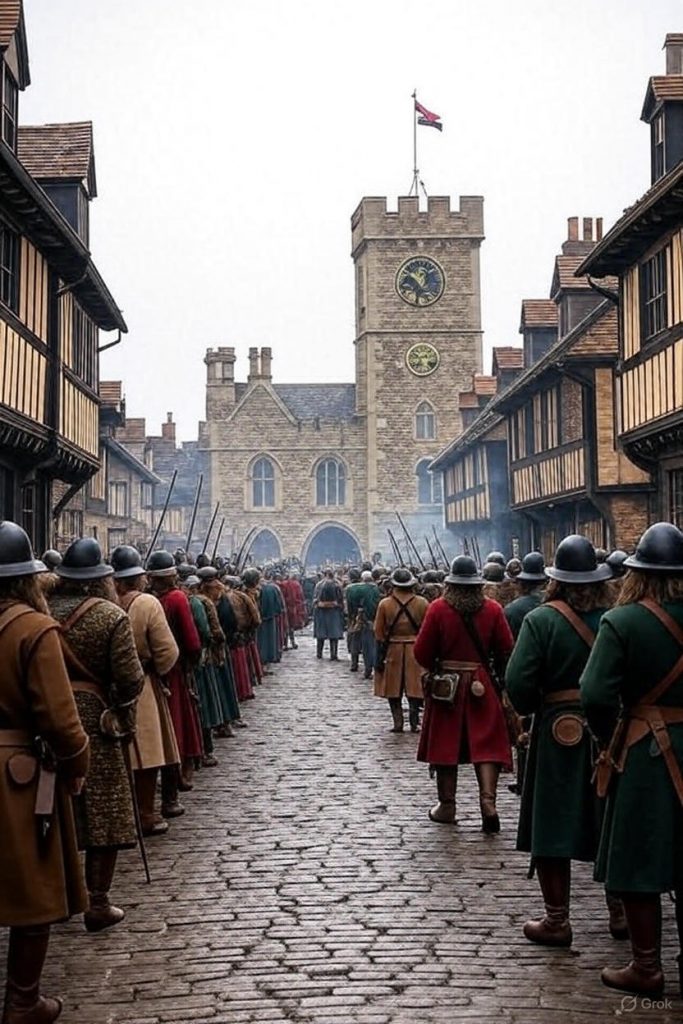King’s Lynn: A Port Under Pressure
By the summer of 1643 King’s Lynn was not just another provincial town; it was a prize. Sitting on the River Great Ouse with links to London, the Wash, and the North Sea, its merchants traded far beyond Norfolk’s marshes. Whoever held Lynn could control supplies into Parliamentarian East Anglia, and – just as importantly – deny its use to the king.
When civil war broke out in 1642, Lynn’s first instinct was caution. Its governing elite – mayor, aldermen, and wealthy merchants – hesitated. But neutrality was never really an option. The port was too important, its ships too valuable, its walls too tempting. In August 1643, the town finally declared for the king, and in doing so set itself on a collision course with Parliament’s armies.
Lynn’s Royalist Gamble
The decision was not unanimous. While the mayor, Thomas Gurlin, and his allies leaned Royalist, plenty of townspeople favoured Parliament. But when two outspoken Parliamentarian MPs were detained in the Guildhall, the die was cast. Gurlin handed the governorship to Sir Hamon L’Estrange, a veteran Norfolk Royalist.
L’Estrange was a seasoned campaigner, but he had never commanded a town through a modern siege. He relied on the loyalty of Lynn’s trained bands and the goodwill of the townsfolk. Some were willing enough; others were wary. Merchant families stood to lose fortunes if trade was disrupted. The poor, already struggling, faced the prospect of shortages. Yet for all these misgivings, Lynn braced itself for war.
The Shadow of Parliament
Parliament, by contrast, acted with ruthless clarity. The Eastern Association – its regional army – was already mobilised across East Anglia, with capable commanders such as the Earl of Manchester and Oliver Cromwell ready to enforce obedience. Lynn’s defection to the king could not be ignored.

By the end of August, Parliamentarian troops had crossed into Norfolk. Local villages were compelled to support them, supplying food and timber for siege works. To the countryside, it may have looked like a clash of giants far away had suddenly arrived at their doorsteps.
Lynn’s Siege and Counter-Siege
The siege itself began in earnest on or about 28 August 1643. Parliamentarian batteries were placed along the west bank of the river, where guns could fire into the heart of Lynn. Within days, a shot had punched through the great church of St Margaret, scattering the congregation mid-sermon. Such incidents had an effect beyond their physical damage; they showed the defenders that sacred places, civic pride, and centuries of heritage offered no shield.
Meanwhile, the attackers diverted streams to deprive the town of fresh water. Cisterns ran low. Women queued anxiously at wells, watching the level fall day by day. Thirst was accompanied by fear. Parliament’s men made a habit of parading the corpses of slain defenders in view of the walls, a grisly form of psychological warfare.
Yet Lynn was not defenceless. Musketeers manned the ramparts. Cannon were hauled into place on the towers. Royalist sympathisers from outside attempted to slip supplies in by boat, though few succeeded. Fires were set in outlying houses so that they could not shelter enemy troops. For a time, the defenders gave as good as they got.
Inside the Walls of Lynn: Anxiety and Division
Conditions inside the town worsened as the days passed. Food prices rose sharply. Beer and bread were rationed. Wealthier households retreated behind bolted doors, fearful of unrest from their poorer neighbours as much as from the besiegers outside.
Lynn was a town of many voices, and during the siege they clashed. Royalists insisted that relief from the king must surely be coming. Parliamentarians whispered that resistance was madness and would bring ruin on all. Some men deserted their posts. Others doubled down, swearing oaths of loyalty to L’Estrange. The tension must have been palpable: families divided by politics, friendships strained, churches filled with rumour.
The Collapse of Hope in Lynn
By the second week of September, illusions of outside rescue collapsed. Charles I was tied up in the Midlands, his resources stretched thin. Prince Rupert’s cavalry were nowhere near Norfolk. For the garrison on Lynn’s walls, it was now a matter of endurance alone.
But endurance was no match for overwhelming force. Parliament’s besieging army swelled to thousands – some say as many as 8,000 men – with siege works tightening daily. The town’s leaders, weighing loyalty against survival, faced the inevitable. On 15 September 1643, King’s Lynn capitulated.
Terms of Lynn’s Surrender
The terms were surprisingly lenient. Lynn was to pay £2,300 to prevent looting – an enormous sum, equal to several years of civic revenue. The Royalist governor and a handful of leaders were taken prisoner. But ordinary townsfolk were spared reprisals. Trade, Parliament recognised, was too valuable to crush.

The surrender was humiliating but also a relief. After weeks of fear, bombardment, and deprivation, Lynn’s people could at least return to something like normal life, though under very different masters.
Re-Engineering Fortress Lynn
Parliament’s next move was not to punish but to secure. They recognised that Lynn, once fortified properly, could become the linchpin of their control in East Anglia. Enter Richard Clampe, physician and mathematician. Clampe designed a radical system of earthworks: wide ditches, angled bastions, and sloping ramparts capable of deflecting artillery fire.
Unlike medieval stone walls, which crumbled under cannon, these new earthworks absorbed impact. Lynn was reshaped almost overnight into a modern fortress of the “trace italienne” type, the very cutting edge of seventeenth-century military science. Archaeology has revealed traces of these works in unexpected places – fields with odd ridges, alignments that make little sense until one realises they are the ghostly remnants of a Civil War stronghold.
The Price of Loyalty
The financial and social burden of these changes was crushing. Beyond the £2,300 fine, Lynn had to bear the cost of housing and supplying a garrison. Timber, brick, and stone were requisitioned for defences. Stores of grain were seized for soldiers’ rations. For merchants, it meant dwindling profits. For labourers, it meant heavy work with little pay.
The psychological burden was no lighter. To live under a garrison commanded by Colonel Valentine Walton, Cromwell’s brother-in-law, was to endure constant reminders of defeat. Soldiers patrolled the streets, and military authority overshadowed civic traditions. Lynn’s proud autonomy was curtailed.
Lynn’s Lingering Discontent
Royalist feeling did not disappear. In 1645, townsmen tried unsuccessfully to return a Royalist MP. Five years later, in 1650, an attempt at rising was made, though quickly crushed. Such gestures reveal how deep loyalties ran, and how little a fine or garrison could change hearts.
Meanwhile, the town’s infrastructure suffered. By 1648 observers noted that Lynn “wanted much repair,” its houses and quays decaying under the weight of debt and neglect. Trade limped on, but the boom years seemed far away.
Restoration Joys, Bitter Memories
When Charles II was restored in 1660, Lynn erupted in celebration. Bonfires were lit, bells rang from the towers, and processions filled the streets. A group of maidens dressed in white paraded through the town, symbolising renewal and purity. It was as if the town wished to wash away two decades of compromise, debt, and humiliation.
Yet memory is not so easily erased. The siege had left scars—economic scars in the form of debt; physical scars in the landscape of earthworks; and emotional scars in families that had been divided. For generations, Lynn’s story of 1643 remained one of both pride and pain.
Why the Siege Still Matters
The Siege of King’s Lynn may not rank alongside Naseby or Marston Moor in the great battles of the Civil War, but in microcosm it shows the human drama of that conflict.
It reveals how ordinary townspeople were caught between loyalty to king, pressure from Parliament, and the need simply to survive. It shows how the new science of fortification reshaped even provincial towns. And it reminds us that wars are fought not only in fields but in streets, churches, and kitchens.
For King’s Lynn, 1643 was a year when loyalties were tested, hopes raised and dashed, and the price of political choice paid in silver, sweat, and sorrow.
📜 Timeline: The Siege of King’s Lynn, 1643
- Summer 1643 – Lynn’s leaders hesitate over allegiance in the Civil War. Royalist sympathies grow among the mayor and aldermen.
- August 1643 – Two Parliamentarian MPs are arrested in Lynn; the town declares for the king. Sir Hamon L’Estrange appointed governor.
- 28 August 1643 – Parliament’s Eastern Association army begins siege operations around Lynn. Artillery batteries set up along the west bank of the River Ouse.
- Early September 1643 – Bombardment damages St Margaret’s Church. Water supplies cut. Shortages of food and drink inside the town.
- First week of September 1643 – Parliament’s army swells to thousands. Psychological pressure mounts: bodies of slain defenders displayed.
- Mid-September 1643 – Hopes of Royalist relief fade as Charles I is tied down elsewhere.
- 15 September 1643 – King’s Lynn capitulates. A fine of £2,300 imposed to prevent plunder. Governor and leaders taken prisoner.
- Late 1643 onwards – Richard Clampe redesigns Lynn’s defences with modern earthworks; town remains under Parliamentarian garrison.
- 1645–1650 – Sporadic attempts to revive Royalist sympathy, including an abortive rising.
- 1660 – Restoration of Charles II greeted with celebrations in Lynn, including a parade of maidens in white.
Further Reading
The Siege of King’s Lynn 1643 (1 of 4) Which Side?
The Siege of King’s Lynn 1643 (2 of 4) Grenadoes
The Siege of King’s Lynn 1643 (3 of 4) The Ending
The Siege of King’s Lynn 1643 (4 of 4) Afterwards
Book a Walk with a Trained and Qualified King’s Lynn Guide Through Historic Lynn
Sources
- Flintham, D. (2018) Richard Clampe, Fortress Engineer, c1617-1696, FORT vol.46, pp.3-14
- Hillen, H.J. (1907) History of the Borough of King’s Lynn, Vol.1, EP Publishing Ltd.
- Holmes, C. (1974) The Eastern Association in the English Civil War, Cambridge University Press
- ‘House of Commons Journal Volume 4: 5 May 1646’, in Journal of the House of Commons: Volume 4, 1644-1646 (London, 1802), pp. 534-535. British History Online http://www.british-history.ac.uk/commons-jrnl/vol4/pp534-535 (accessed April 2021)
- Ketton-Cremer, R.W. (1985) Norfolk in the Civil War: A Portrait of a Society in Conflict, Gliddon Books.
- Kyle, C. https://www.historyofparliamentonline.org/volume/1604-1629/member/lestrange-sir-hamon-1583-1654 (accessed April 2021)
- Withers, A. (2023) Great Staughton And Its People, Unknown
- Yaxley, S. ed. (1993) ‘A briefe and true Relation of the Siege and Surrendering of Kings Lynn to the Earle of Manchester’. In Yaxley, S. (1993) The Siege of King’s Lynn 1643, The Larks Press
© James Rye 2025
